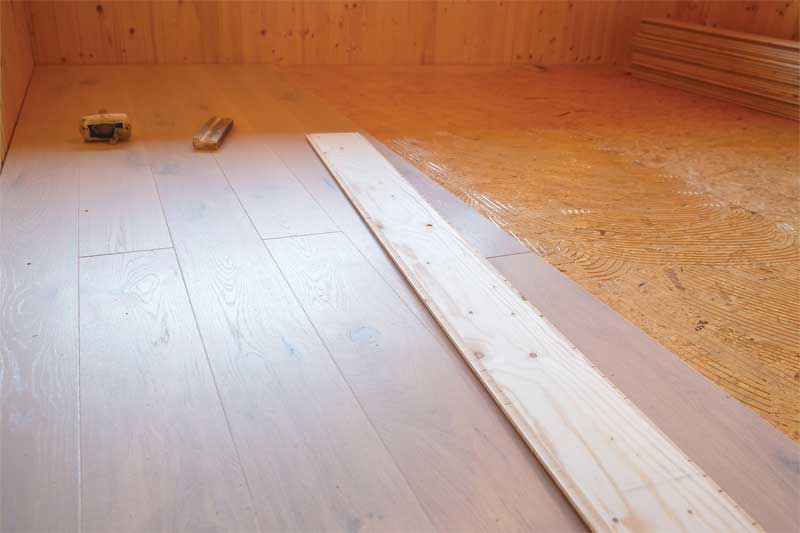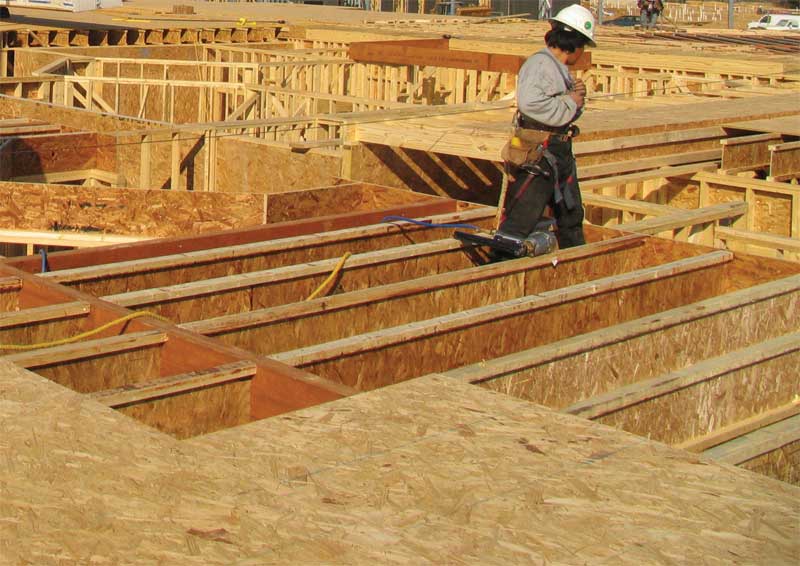
I-joists
Prefabricated wood I-joists of 241 mm (9 1/2 in.) in depth minimum, with flange size of 25.4 mm (1 1⁄8 in.) in thickness x 25.4 mm (1 3⁄4 in.) in width minimum, at a maximum joist spacing of 610 mm (24 in.) o.c.
Cavity insulation
A 76.2-mm (3 1/2-in.) thick R-13 fiberglass batt insulation should be installed in the joist cavities with the exception of the floor assembly covered by cushioned vinyl, in which a layer of 76-mm (3-in.) thick mineral wool (44.8 kg/m3 [2.8 pcf]) insulation should be installed instead.
Resilient channel
RC-1 resilient channels (0.43 mm [0.017 in.] thick) should be installed perpendicular to the bottom of the I-joist flanges at 406 mm (16 in.) o.c. with 25.4-mm (1 ¼-in.) Type W drywall screws.
Gypsum board
Two layers of 16-mm (5⁄8-in.) Type X gypsum boards complying with ASTM C1396, Standard Specification for Gypsum Board, should typically be attached perpendicular to the resilient channels with 25-mm (1-in.) and 25.4-mm (1 5⁄8-in.) Type S drywall screws at 305 mm (12 in.) o.c. for the base and face layers of gypsum boards, respectively.
Acoustic performance
The 2015 International Building Code (IBC) specifies a minimum STC rating of 50 for walls, partitions, and floor-ceiling assemblies between adjacent dwelling units and sleeping units, or between such units and adjacent public areas, when tested in accordance with ASTM E90, Standard Test Method for Laboratory Measurement of Airborne Sound Transmission Loss of Building Partitions and Elements, and analyzed in accordance with ASTM E413, Classification for Rating Sound Insulation. The 2015 IBC also specifies a minimum IIC rating of 50 when tested in accordance with ASTM E492, Standard Test Method for Laboratory Measurement of Impact Sound Transmission through Floor-ceiling Assemblies Using the Tapping Machine, and analyzed in accordance with ASTM E989, Standard Classification for Determination of Impact Insulation Class (IIC). The 2015 International Residential Code (IRC) stipulates a rating of 45 for both STC and IIC in the non-mandatory Appendix K, Sound Transmission.
The STC rating for the assemblies previously described is determined in accordance with ASTM E90 and ASTM E413, and the IIC rating is determined in accordance with ASTM E492 and ASTM E989.

As shown in Figure 2, the STC and IIC ratings for these assemblies are well within the range of acceptable ratings for multifamily residential and nonresidential buildings. The STC ratings are based on the bare floor without the addition of floorcovering. However, they are not typically affected by the finished flooring, except when it adds significant mass. Therefore, the actual performance of the floor assemblies with a floorcovering may be slightly better than the STC ratings tabulated in Figure 2. The tabulated STC and IIC ratings assume recognized precautions are taken for preventing flanking noise and sound leaks, and the construction also conforms to the assemblies previously described. However, conditions at each site may vary widely, and the STC and IIC ratings may not guarantee acceptable performance to all occupants.
In interpreting these results, some modifications can be made without discernible change in sound-insulating properties. For instance:
1. Any prefabricated wood I-joists conforming to ASTM D5055, Standard Specification for Establishing and Monitoring Structural Capacities of Prefabricated Wood I-Joists, can be employed, provided the joists are 228.6 mm (9 1⁄2 in.) or deeper, the flange size is at least 25.4 mm
(1 1⁄8 in.) in thickness x 25.4 mm (1 3⁄4 in.) in width, and joists are spaced a maximum of 610 mm (24 in.) o.c.
2. Plywood, oriented strand board (OSB), and composite panel floor sheathing conforming to DOC PS1 or PS2 are interchangeable on a thickness-for-thickness basis.
3. Wood structural panels of 19⁄32 and 5⁄8 Performance Categories are interchangeable, and 23⁄32 and 3/4 Performance Categories are interchangeable.
4. A 76-mm (3-in.) mineral wool insulation (44.8 kg/m3
[2.8 pcf]) can substitute for 89-mm (3 1/2-in.) thick R-13 fiberglass insulation.
Fire rating
The floor-ceiling assemblies described in this article are required to be installed with two layers of 15.9-mm (5⁄8-in.) Type X gypsum board at the exposed side of the assemblies. These systems can be assigned one-hour fire rating based on the component additive method prescribed in Section 722.6, “Wood Assemblies,” of the 2015 IBC. As a comparison, these assemblies are practically the same as the one-hour fire-rated floor-ceiling assembly in Item 21-1.1 of Table 721.1(3), “Minimum Protection for Floor and Roof Systems,” of the 2015 IBC.
Thomas D. Skaggs, PhD, PE, is the manager of product evaluation in APA–The Engineered Wood Association’s technical services division. During his 23 years at APA, he has been actively involved in dynamic testing of products, including evaluating the vibration performance of I-joist floor systems and cyclic performance of braced and shear wall assemblies. He was also involved in the design and implementation of APA’s full-size three-dimensional house testing program. Prior to joining APA, Skaggs’ research at Virginia Tech was in the area of metal-plate-connected wood trusses. He can be reached at tom.skaggs@apawood.org.




